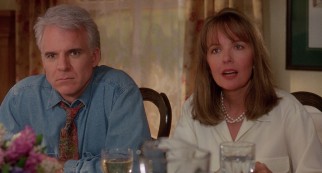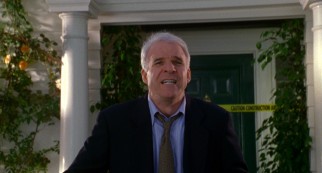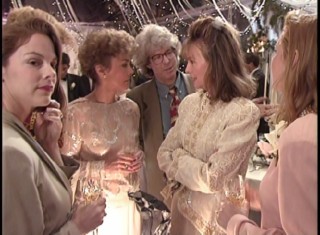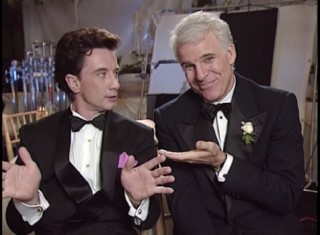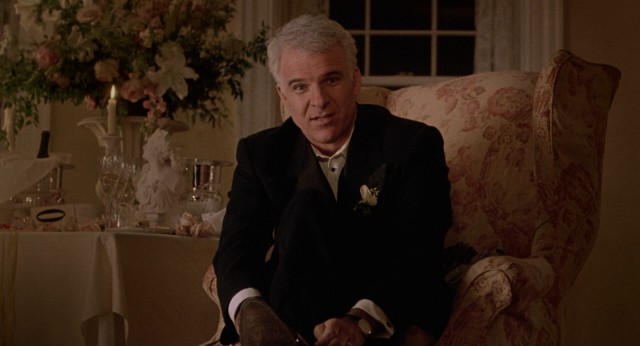Father of the Bride (20th Anniversary Edition) & Father of the Bride Part II: 2 Movie Collection Blu-ray + DVD Review
 |
Father of the Bride
Theatrical Release: December 20, 1991 / Running Time: 105 Minutes / Rating: PG / Songs List Director: Charles Shyer / Writers: Frances Goodrich, Albert Hackett, Nancy Meyers, Charles Shyer (screenplay); Edward Streeter (novel Father of the Bride) Cast: Steve Martin (George Banks), Diane Keaton (Nina Banks), Kimberly Williams (Annie Banks-MacKenzie), Kieran Culkin (Matty Banks), George Newbern (Bryan MacKenzie), Martin Short (Franck Eggelhoffer), B.D. Wong (Howard Weinstein), Peter Michael Goetz (John MacKenzie), Kate McGregor Stewart (Joanna MacKenzie), David Pasquesi (Hanck the Caterer), Richard Portnow (Al the Tux Salesman), Chauncey Leopardi (Cameron), Steve Tyrell (Bandleader), Eugene Levy (Auditioned Singer), Tom Irish (Ben Banks) |
 |
Father of the Bride Part II
Theatrical Release: December 8, 1995 / Running Time: 106 Minutes / Rating: PG / Songs List Director: Charles Shyer / Writers: Nancy Meyers, Charles Shyer (screenplay); Albert Hackett, Frances Goodrich (screenplay Father's Little Dividend); Edward Streeter (characters) Cast: Steve Martin (George Banks), Diane Keaton (Nina Banks), Martin Short (Franck Eggelhoffer), Kimberly Williams (Annie Banks-MacKenzie), George Newbern (Bryan MacKenzie), Kieran Culkin (Matty Banks), B.D. Wong (Howard Weinstein), Peter Michael Goetz (John MacKenzie), Kate McGregor Stewart (Joanna MacKenzie), Jane Adams (Dr. Megan Eisenberg), Eugene Levy (Mr. Habib), Jay Wolpert (Dr. Phil Brooks), Lori Alan (Mrs. Habib), Peter Spears (Dr. Wagner), Dulcy Rogers (Ava the Beautician), Nora Dunn (Real Estate Agent - uncredited) |
Buy Father of the Bride & Father of the Bride Part II from Amazon.com:
2-Movie Collection Blu-ray + DVD Double Feature 2-DVD Set
The Onion's cynical but non-satirical A.V. Club recently pinpointed Father of the Bride as the moment Steve Martin's film career went south. I don't agree with that assessment, but there is undoubtedly some truth in it. One of the better-selling titles from Disney's Touchstone Pictures division, Father of the Bride makes its Blu-ray debut Tuesday, well in time for Father's Day, in a 3-disc set that is declared both a 20th Anniversary Edition (a year after the movie celebrated that milestone) and a 2-Movie Collection. The movie shares a Blu-ray with its 1995 sequel Father of the Bride Part II and, to cover bases, each is presented on a DVD as well.
Martin plays George Banks (a name familiar to Mary Poppins fans), the owner of an athletic shoe company. In voiceover, George makes clear that he enjoys his life in the small Southern California town of San Marino and is not a big fan of change. When his 22-year-old aspiring architect daughter Annie (Kimberly Williams, "Williams-Paisley" since 2003) returns from a semester in Rome with the news that she's met someone and is now engaged, George is shocked and disgusted.
He is prepared to hate her groom, "independent communications consultant" Bryan MacKenzie (George Newbern) and his wealthy parents with their Bel-Air mansion. But, this is not that kind of movie. The in-laws-to-be are pretty much perfect and George's wife Nina (Diane Keaton) could not be happier. The whole thing, however, isn't sitting well with George for two big reasons. First, there is coming to terms with his baby girl being all grown up. Secondly, there is the wedding itself, a daunting event whose outlandish costs are, per tradition and pride, George's responsibility.
The film offers a mix of a little more comedy than drama. Naturally, the planning accounts for the bulk of the former and of onscreen action. The Banks have hired Franck (Martin Short), an eccentric wedding coordinator whose thick nonspecific European accent confounds George. Of course, every aspect of the large ceremony and reception has to be considered, from food to cake to music to attire to parking attendants. The presents and RSVPs start rolling in and, even with his limited involvement in all this, George is overwhelmed.
The original 1950 Father had Frances Goodrich and Albert Hackett adapt a new bestselling novel by Edward Streeter. Wife and husband Goodrich and Hackett worked steadily through the first three full decades of talking pictures, scripting such works as The Thin Man (and two of its sequels), It's a Wonderful Life, Seven Brides for Seven Brothers, and Easter Parade. Inevitably, remaking their movie yields something a bit corny and old-fashioned. The modern duo with whom Goodrich and Hackett share screenplay credit here are Nancy Meyers and Charles Shyer, The primarily internalized drama within Martin's protagonist goes a long way to prevent this 1991 Father from being just another dumb wedding comedy. The opening direct audience address, ongoing narration, and constant focus on the titular character distinguish this movie from others covering similar territory. This is not about a bride's excitement, a career bridesmaid's lack of love, or a groom's trepidation. It is about the male equivalent of postpartum depression occurring a generation after a birth. It makes for a poignant perspective and one rarely given much thought. You can question whether George Banks is overreacting (which he basically identifies as his defining character trait) and overestimating how much his daughter's marriage will change the extent of his fatherhood. But many good points are raised and sharply so.
Based on the 1951 sequel Father's Little Dividend, Father of the Bride Part II reunites the entire principal cast for another life/family milestone. Two, in fact.
First, Annie and Bryan call their families together to share some big news: they're having a baby. True to form, George isn't thrilled with the announcement. He's reluctant to become a grandfather, I guess, although there isn't the strongest of reasoning there.
Uncharacteristically, George decides the family should sell their leaky old house and buy a condo on the beach. After several months go by without a nibble, George suddenly gets a hasty offer from Turkish businessman Mr. Habib (Eugene Levy, playing a different, more substantial, and more offensive role than his brief appearance in the predecessor). Given a $15,000 bonus, the Banks have ten days to move out.
Meanwhile, George accompanies Nina to her OB/GYN, where they discover -- shock! -- she too is pregnant. Like daughter, like mother. George and Nina think it's pretty crazy to be scheduled to reenter parenthood just a few weeks after entering grandparenthood. They bicker over the situation, but make peace shortly after George saves the family home from the shrewd Habib's wrecking ball.
The film's final half-hour goes to that improbable yet inevitable scenario: both Annie and Nina go into labor on the same night. It happens to be a night when George has taken two potent sleeping pills given to him by Franck. Martin Short's popular wacky supporting character has been elevated in prominence this time around, getting hired not only to plan what will be a double baby shower but also to oversee the construction of a nursery for the Banks' unplanned baby.
Part II makes a clear effort to find its forebear's balance of humor and heart, hitting on many of the same beats. It skews even further to comedy than drama with the latter not having as sturdy a foundation. It's not as good as the predecessor, but it's not too far from it, ending up in the same pleasing league as it and other mid-level Steve Martin films.
Martin's Father of the Bride grossed $89 million domestically, which made it ninth among 1991 releases. Four years later, this sequel found just a little less profitability, earning $76.6 million, which was good enough for 17th place out of 1995's more numerous and appealing offerings. VIDEO and AUDIO
The Blu-ray boasts terrific picture quality. You don't expect the '90s Father of the Bride movies to look great, but they do, especially the original. Its 1.85:1 element is clean and sharp, offering an appropriate amount of light film grain, good detail, and warm colors. Part II's is fairly solid too. It seems a little bit on the dark side and its grain is a little more noticeable and bothersome, but on the whole, the results are still quite pleasing.
Both films have their soundtracks satisfactorily presented in 5.1 DTS-HD master audio. These are not sound-driven movies, but the dialogue, minimal ambience, and Steve Tyrell music hold some weight, are pleasing to the ear, and remain crisp and intelligible throughout, although you may have to turn up the volume in quieter moments. Strangely, Part II loses the Spanish subtitles from its DVD, unfortunate for the few viewers that should concern.
The DVDs are the same as those sold separately and bundled together. The original movie hails from 2005 (Disney's math was off then to, for its premature 15th Anniversary Special Edition) and is anamorphic and respectable (but a far cry from 1080p). Part II is from all the way back in 2000 and thus isn't even enhanced for 16:9 displays or anywhere near as stellar as a five-year-old movie would look on DVD these days.
BONUS FEATURES, MENUS, PACKAGING and DESIGN
No new bonus features are offered here and the Blu-ray inexplicably leaves Part II's extras exclusive to its DVD. Three supplements for the original movie do make it to the double feature platter.
First and most substantial is an audio commentary recorded for the 2005 DVD reissue by co-writer, producer, and director Charles Shyer, which shows up not with the other bonus features but when you select "Play." Surprisingly, he is not all that big on the 1950 movie, saying it doesn't hold up well and discussing how he set out to make this version his own. He recalls production experiences in great detail, The other two bonuses are videos, both from 1991 and appearing in 1.33:1 standard definition. "An Invitation to Father of the Bride" (10:36) serves up an ordinary supply of movie clips, behind-the-scenes footage, and cast/crew remarks. It is a standard but fun promotional featurette.
"Martin & Short Interview Each Other" (5:14) pulls from the same session as the aforementioned, as Steve Martin and Martin Short bounce off one another with sarcasm and barbs.
The original movie's DVD offers the same three extras. Like before, it drops the one bonus feature from the film's initial 1999 DVD: the original theatrical trailer. Seems like that would have been worth including on the Blu-ray, but no dice.
On its DVD, Part II is joined by its original theatrical trailer (2:35) and the short, routine promotional featurettes "Production Story" (4:20) and "Just Between Friends" (3:53). They add talking heads, B-roll, narration, and more playful Martin and Short banter to trailer clips. Despite what the packaging states, Part II does not include an audio commentary by Steve Martin and Martin Short. You'd think that someone would have noticed this glaring goof/false advertising twelve years later, but that is simply not the case.
The obvious question is why not place these Part II DVD extras on the Blu-ray as well, when space allowed and including them couldn't have required much more work than dragging and dropping files? What Blu-ray owner is going to want to insert the DVD to watch a trailer or promotional short?
The Blu-ray opens with an HD trailer for The Odd Life of Timothy Green and an anti-tobacco truth spot. Being a Buena Vista BD, it neither supports bookmarks nor resumes playback. Furthermore, the disc even fails to uphold the studio's usual practice of remembering where you left off in the movie if you couldn't finish in one sitting.
Dated trailers launch the DVDs, with a Herbie: Fully Loaded sizzle reel, The Pacifier trailer, and "Home Improvement": The Complete Second Season DVD ad accompanying the original movie and a Happy, Texas preview preceding Part II.
The Blu-ray's simple menu displays the centerpiece of the two movies' poster art while score plays and listings are given wedding invitation-type borders. The original's DVD plays clips in a horizontal photo frame. Part II's old DVD features static, silent CD-ROM-ish 4:3 selection screens.
The three discs are held in a standard Blu-ray case with a swinging tray and nary an insert nor slipcover.
CLOSING THOUGHTS
Sure, the 1990s Father of the Bride may be sentimental, now dated, and never especially funny, but it remains sweet, thoughtful, and appealing as well. This 2-Movie Collection Blu-ray treats each installment to a satisfying hi-def presentation. While it would seem to be in Disney's interest to simply include all the DVD bonus features on the Blu-ray, there's also something to be said for getting the DVDs included right there with the new Blu-ray and with no perceivable increase in the reasonable list price. Though the set seems destined to get a price cut in the not so distant future, even right now, it warrants a mild recommendation.
Buy Father of the Bride & Father of the Bride Part II from Amazon.com:
|
Related Reviews:
Father of the Bride Part II Songs List: Steve Tyrell - "Give Me the Simple Life", Fats Domino - "When the Saints Go Marching In", Etta James - "At Last", Philip Ingram - "Remembering Annie", Steve Tyrell - "On the Sunny Side of the Street", "Pretty Baby" DVDizzy.com | DVD and Blu-ray Reviews | New and Upcoming DVD & Blu-ray Schedule | Upcoming Cover Art | Search This Site
DVDizzy.com Top Stories:
Steve Martin: Planes, Trains & Automobiles The Big Year Shopgirl The Muppet Show: Season Two The Muppet Movie
Diane Keaton: Annie Hall Morning Glory The Godfather Trilogy Mama's Boy | George Newbern: Dadnapped
Martin Short: The Santa Clause 3: The Escape Clause Jungle 2 Jungle Saturday Morning Cartoons: 1980s The Spiderwick Chronicles
Nancy Meyers and Charles Shyer: The Parent Trap (1998) | Frances Goodrich and Albert Hackett: It's a Wonderful Life
New: Clueless Men in Black Men in Black II Love Is On the Air Albert Nobbs The Iron Lady W./E.
Weddings: License to Wed Four Weddings and a Funeral The Royal Wedding: William & Catherine | Pregnancy: Juno The Back-up Plan
Father of the Bride Songs List: The Temptations - "My Girl", New Leipzig Bach Collegium Musicum - Bach's "Minuet and Badinere", Steve Martin - "What's New Pussycat?", Eugene Levy - "Volare", Eugene Levy - "Nel Blu Dupinto Di Blu", The Dixie Cups - "Chapel of Love", "Perfect Match", "Isn't It Romantic", Darlene Love - "(Today I Met) The Boy I'm Gonna Marry", David Darling - "I'm Your Man", Steve Tyrell - "My Girl", Steve Tyrell - "The Way You Look Tonight", "Beyond the Sea"
Text copyright 2012 DVDizzy.com. Images copyright 1991-1995 Touchstone Pictures and 2000-2012 Touchstone Home Entertainment and Buena Vista Home Entertainment.
Unauthorized reproduction prohibited.
